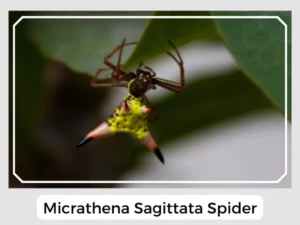Ever heard of micrathena spiders? They’re a kind of orb-weaver spider found in places like Brazil, Peru, and even Ecuador. With around 119 different types, many of these spiders like to live in the woods.
They are small and round mostly laid by the female near its web on a leaf.
The majority of the spiders have tightly coiled spiral or circular webs positioned vertically.
The majority of the spiders have tightly coiled spiral or circular webs positioned in a vertical manner.
Yes, Micrathena spiders do have venom. They use it mainly to catch their food, but it’s mostly safe for people.
Micrathena spiders can bite if they feel threatened. It’s similar to a little pinch and doesn’t usually cause problems for most individuals.
Micrathena spiders play a vital role in their ecosystems, helping to control the population of small insects and maintaining ecological balance. Their unique web-building skills and hunting strategies showcase their adaptability and contribution to their habitats.
Natural Predators and Prey-Predator Dynamics: Despite their venomous defense mechanism, micrathena spiders are not without predators. Birds and larger insects pose a threat, creating a delicate balance in the prey-predator dynamics of their environment.
Relationship with Humans: Generally, micrathena spiders and humans maintain a peaceful coexistence. Their preference for woodlands and moist areas means they rarely venture into human dwellings. When they do, their presence is mostly harmless, contributing to the biodiversity of their surroundings rather than posing any threat.
| Distribution | Throughout America (eastern, southern, northern and central parts) |
| Habitat | Most of them dwell in woodlands and moist areas |
| Diet | Birds, flies, and other small insects |
| Lifespan | Approximately 1 -2 years (females live longer than males) |

In summary, Micrathena spiders stand as a testament to the incredible diversity and adaptability of orb-weaver spiders.
Ever heard of micrathena spiders? They’re a kind of orb-weaver spider found in places like Brazil, Peru, and even Ecuador. With around 119 different types, many of these spiders like to live in the woods.
They are small and round mostly laid by the female near its web on a leaf.
The majority of the spiders have tightly coiled spiral or circular webs positioned vertically.
The majority of the spiders have tightly coiled spiral or circular webs positioned in a vertical manner.
Yes, Micrathena spiders do have venom. They use it mainly to catch their food, but it’s mostly safe for people.
Micrathena spiders can bite if they feel threatened. It’s similar to a little pinch and doesn’t usually cause problems for most individuals.
Micrathena spiders play a vital role in their ecosystems, helping to control the population of small insects and maintaining ecological balance. Their unique web-building skills and hunting strategies showcase their adaptability and contribution to their habitats.
Natural Predators and Prey-Predator Dynamics: Despite their venomous defense mechanism, micrathena spiders are not without predators. Birds and larger insects pose a threat, creating a delicate balance in the prey-predator dynamics of their environment.
Relationship with Humans: Generally, micrathena spiders and humans maintain a peaceful coexistence. Their preference for woodlands and moist areas means they rarely venture into human dwellings. When they do, their presence is mostly harmless, contributing to the biodiversity of their surroundings rather than posing any threat.
| Distribution | Throughout America (eastern, southern, northern and central parts) |
| Habitat | Most of them dwell in woodlands and moist areas |
| Diet | Birds, flies, and other small insects |
| Lifespan | Approximately 1 -2 years (females live longer than males) |

In summary, Micrathena spiders stand as a testament to the incredible diversity and adaptability of orb-weaver spiders.